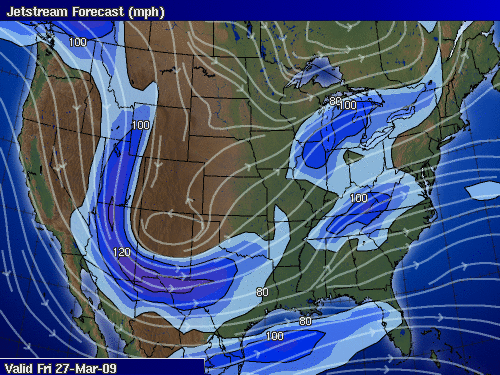 | Jet Stream |
|
|
|
|
The Jet Stream map shows today''s high wind speed levels and jetstream directions. Jet streams are fast flowing, relatively narrow air currents found in the atmosphere around 10 kilometers above the surface of the Earth. They form at the boundaries of adjacent air masses with significant differences in temperature, such as the polar region and the warmer air to the south. The jet stream is mainly found in the tropopause, at the transition between the troposphere (where temperature decreases with height) and the stratosphere (where temperature increases with height).
Jet streams are fast flowing, narrow air currents found at the tropopause, the transition between the troposphere (where temperature decreases with height) and the stratosphere (where temperature increases with height),[1] and are located at 10-15 kilometers above the surface of the Earth. They form near boundaries of adjacent air masses with significant differences in temperature, such as the polar region and the warmer air to the south.[2] The path of the jet typically has a meandering shape, and these meanders are one manifestation of Rossby waves. Rossby waves propagate westward with respect to the flow in which they are embedded, which translates to a slower eastward migration across the globe than smaller scale short wave troughs. The major jet streams are westerly winds (flowing west to east) in the Northern Hemisphere. During the summer, easterly jets can form in tropical regions, typically in a region where dry air encounters more humid air at high altitudes. Low level jets can form wherever low level winds are squeezed.
Meteorologists use the location of the jet stream as an aid in weather forecasting. The main commercial use of the jet stream is in air travel, as flight time can be dramatically affected by either flying with or against the stream. One type of clear-air turbulence is found in a jet stream''s vicinity, which can be a hazard to aircraft. One future benefit of the jet stream could be to power airborne wind turbines.
The existence of the jet stream may have been first detected in the 1920s by Japanese meteorologist Wasaburo Ooishi.[3] From a site near Mount Fuji, he tracked pilot balloons, also known as pibals (balloons used to determine upper level winds using a theodolite and the balloon''s known ascension rate due to its internal gas),[4] as they rose into the atmosphere. Ooishi''s work largely went unnoticed outside of Japan. American pilot Wiley Post, the first man to fly around the world solo in 1933, is often given some credit for discovery of the jet stream. Post invented a pressurized suit that let him fly above 6,200 metres (20,000 ft). In the year before his death, Post made several attempts at a high-altitude transcontinental flight, and noticed that at times his ground speed greatly exceeded his air speed.[5] German meteorologist H. Seilkopf is credited with coining the term "jet stream" (Strahlstr÷mung) in a 1939 paper.[6] Many sources credit real understanding of the nature of jet streams to regular and repeated flight-path traversals during World War II. Flyers consistently noticed tailwinds in excess of 100 mph in flights, for example, between the US and UK.[7]



